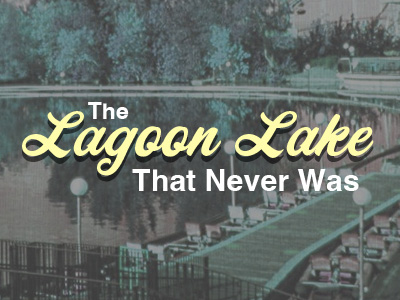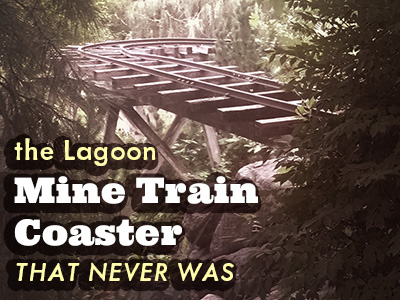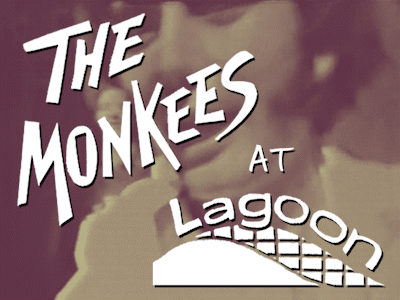As new rides and attractions are added to Lagoon, sometimes it’s necessary to remove an older attraction – often to the dismay of fans. But even then, some remnants are often left behind or repurposed. Here’s a few fragments of the past hiding in plain sight at Lagoon. These are things guests see all the time without realizing or remembering they were once part of a living element of the park.
LAGOON OPERA HOUSE, 1968-1989
Nestled in a corner of the Midway, south of Jet Star 2, is a town square that looks like it came from Victorian-era New England. The biggest draw now is the shaded eating areas and fast food restaurants. Fifty years ago it was much more than that.
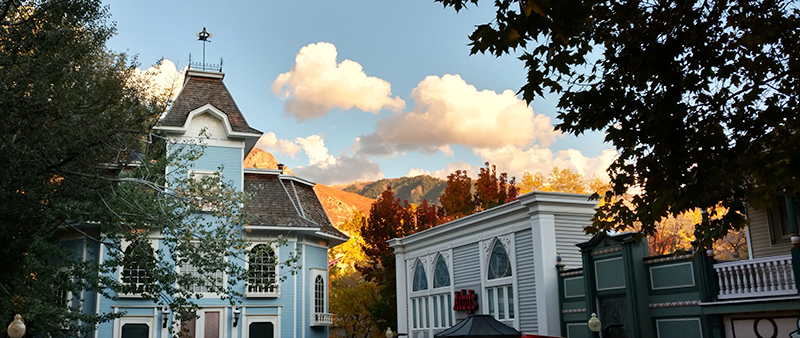
Once called the jewel of summer theater on the Wasatch Front, the 300-seat theater and surrounding square was built using as many authentic furnishings as possible. Year after year, successful shows were put on by Robert Hyde Wilson and actors from the University of Utah. Opera House Square also featured the full service Gaslight Restaurant, Ice Cream Parlor, General Store, Popcorn Wagon and ragtime piano player performing in the square between shows.

In 1980, Lagoon switched from the free admission, pay-per-ride policy to a pay-one-price admission fee, which included unlimited rides, but not shows at the Opera House. Later on, Lagoon leased the Opera House out to other theater companies. In 1989, despite several seasons of critically-acclaimed productions, attendance dropped so much that the show ended two weeks early. It hasn’t reopened since.
Even without the original amenities, the square still provides a quiet, relaxing oasis amidst the modern thrill rides. Subway opened in 1997 with Arby’s arriving in 2001. The theater is still used for entertainment rehearsals and recently, the exterior has undergone repairs to keep it looking fresh.
LAKE PARK DANCING PAVILION, 1886
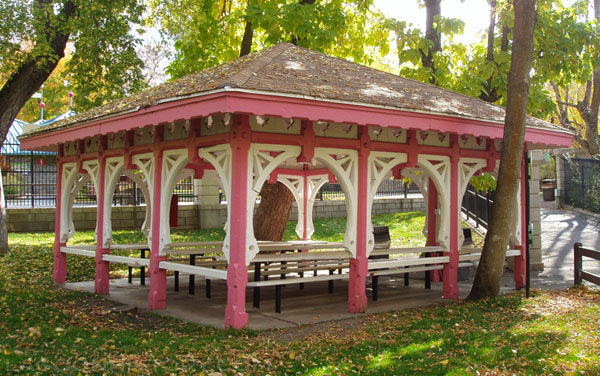
Lagoon has dozens of picnic terraces in the northeast portion of the park. The smallest one, the Rose Terrace, sits east of The Bat. It was actually part of a much bigger structure and dates back to the park’s beginnings on the shore of the Great Salt Lake.
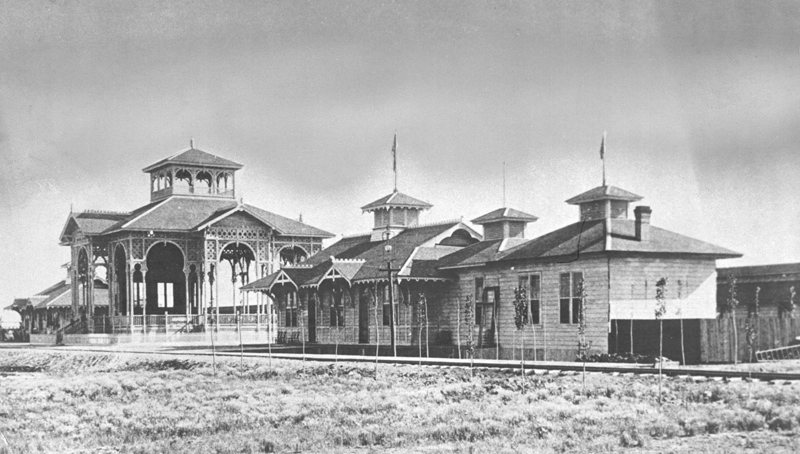
When Simon Bamberger moved most of the buildings from Lake Park inland and renamed the resort Lagoon, the Dancing Pavilion was taken apart and rebuilt at the new park. Later on, the building was modified to become the Lake Park Terrace with the cupola being turned into its own separate structure. The Lake Park Terrace was demolished after the end of the 2004 season to make room for The Bat, making the Rose Terrace the last surviving piece of the Lake Park resort.
LAGOON MINIATURE RAILROAD, 1976-1986

In the Model Train Museum there’s a small train encased in glass. Unlike the toy trains surrounding it, this was once part of a train ride that operated in different parts of Lagoon starting around the 1920s. After two or three decades, the engine and tender were put on display next to Lagoon Lake. When Opera House Square opened, the display moved over there, which is where a miniature train enthusiast saw it and connected Lagoon to someone who could get it running again. The train was brought back to life again in time to become a part of Pioneer Village in 1976. The loading platform was just south of the Bonanza Shooting Gallery and west of the Log Flume.
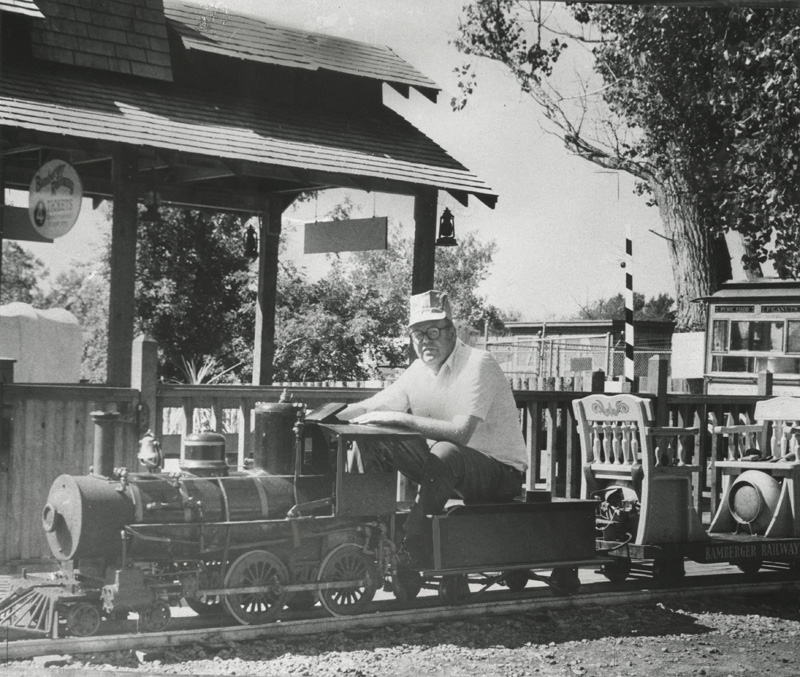
This train ride closed again in the 1980s in preparation for the construction of Lagoon-A-Beach, but never re-opened. The little locomotive was a unique piece of equipment (which was likely custom-made), and it was probably getting difficult to maintain by that time.
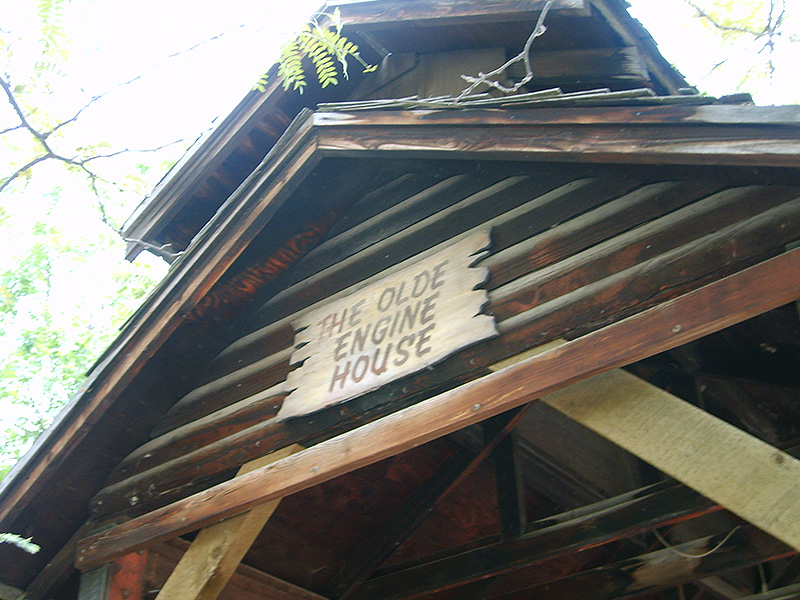
Some stretches of track were still visible for at least a decade after it closed, but all of the track has been removed now. The engine and tender were repainted and put back on display at the Model Train Museum in 2002. The structure from the loading platform was moved east near the Log Flume exit where it housed a group of vending machines. It was removed after the 2024 season when work on The District began.
MOTHER GOOSELAND, 1956-1984
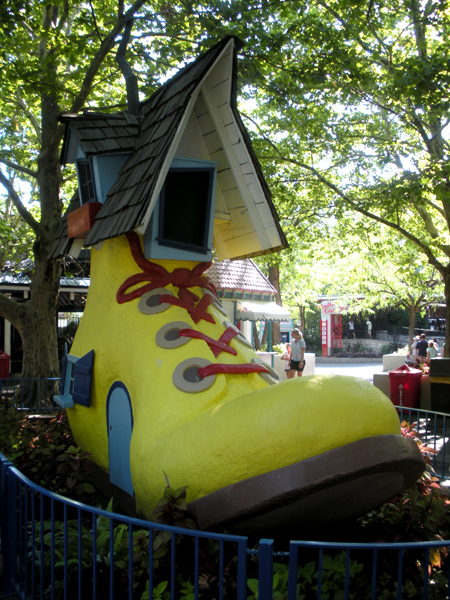
Not far from the Carousel, near the Baby Boats, sits a giant shoe that’s been turned into a house. It represents the old nursery rhyme about the old woman who lived in a shoe. Many people will easily make the connection and some will remember being able to go inside when they were kids. This was just one of several small attractions based on nursery rhymes that were originally part of Mother Gooseland when it opened in 1956. There was also Jack & Jill’s Hill, Peter Peter’s Pumpkin Shell, Humpty Dumpty on his wall and others.
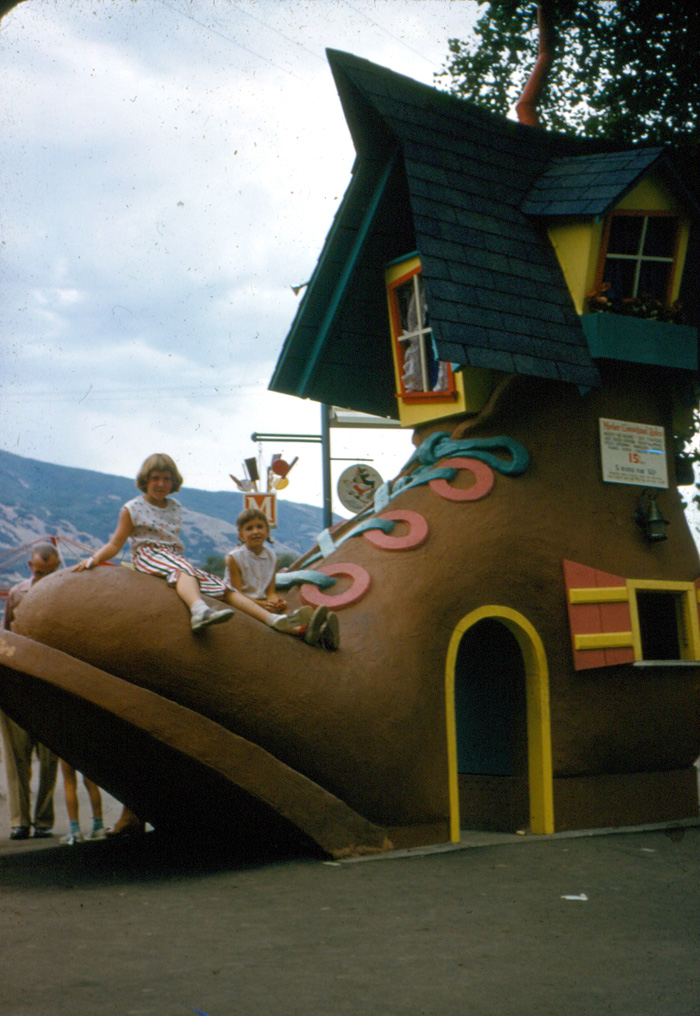
Over the years, pieces of Mother Gooseland were removed, but the shoe has remained for over 60 years. The doors were locked some time around the early 1980s, but it still adds character to Kiddie Land, as the area has been named since 1985.
FUN HOUSE, 1957-1990
To anyone visiting the park after 1990, it’s an odd-shaped building with a long, sloping roof. But to others it can trigger a deeply-cherished childhood memory. It’s actually part of a larger building that used to be the Fun House.
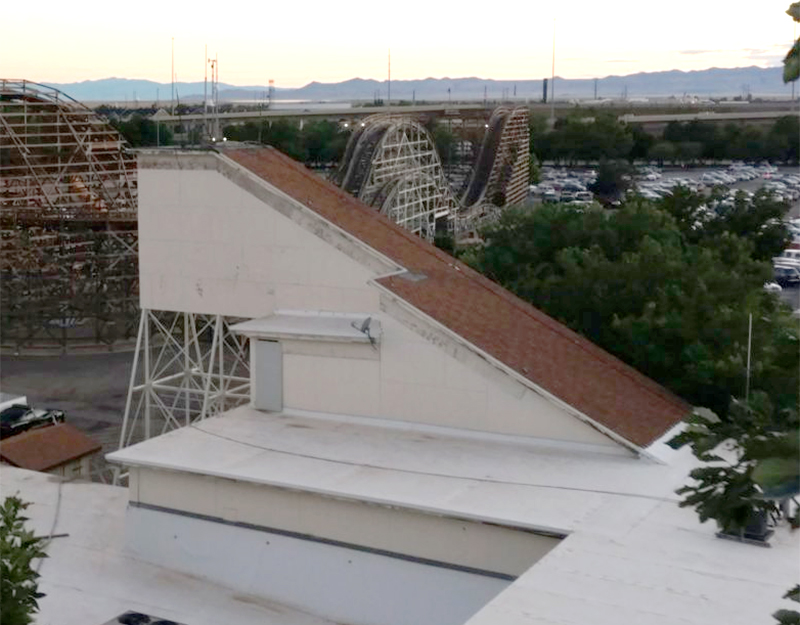
The attraction, completed in 1957, was a replacement for an older Fun House that burned down in the fire of 1953. There were spinning turntables, moving stairs, a spinning barrel – everything you’d expect to find in a classic Fun House. The odd-shaped portion in back housed a set of gunny-sack slides.
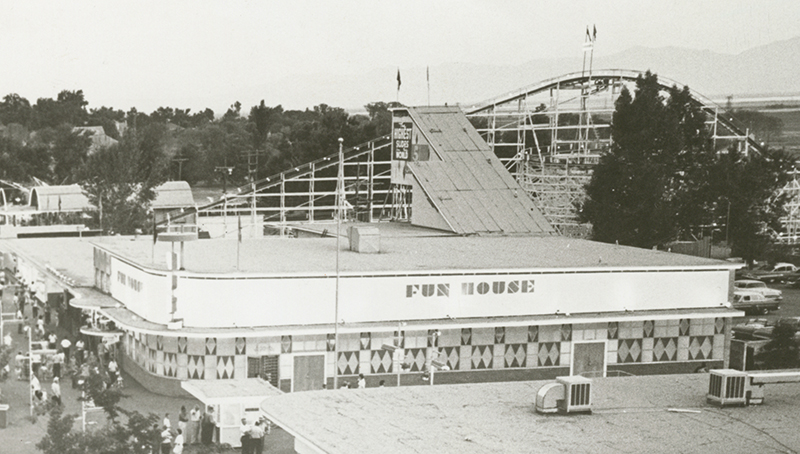
A common explanation for the popular attraction’s closure is one that is well-known in the amusement industry – liability. With all of the fun things one could do in the Fun House, there were even more ways to get hurt doing them. There are also many who remember the Fun House turning into a kind of “day care” where adults would leave their kids to play while they went to enjoy less kid-friendly rides.
The slide tower is the most recognizable element left of the Fun House, but the rest of the building still stands as well. Parts of it have been carved out to accommodate new food outlets, games, lockers, the Safety & Security office and storage space.
Read more about the Fun House here…
PIONEER VILLAGE RAILROAD, 1976-1988
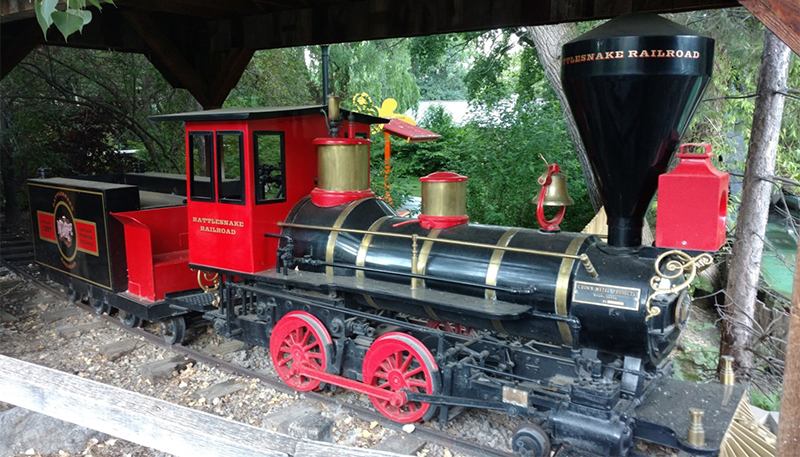
On the way to Rattlesnake Rapids there’s an old miniature locomotive on display bearing the name “Rattlesnake Railroad”. Currently, the Wild Kingdom Train is the only train ride at Lagoon. But from 1976 to 1988, there were two train rides of the same scale, both manufactured by Crown Metal Products of Pennsylvania. The second ride circled the perimeter of Pioneer Village and was named the Pioneer Village Railroad.
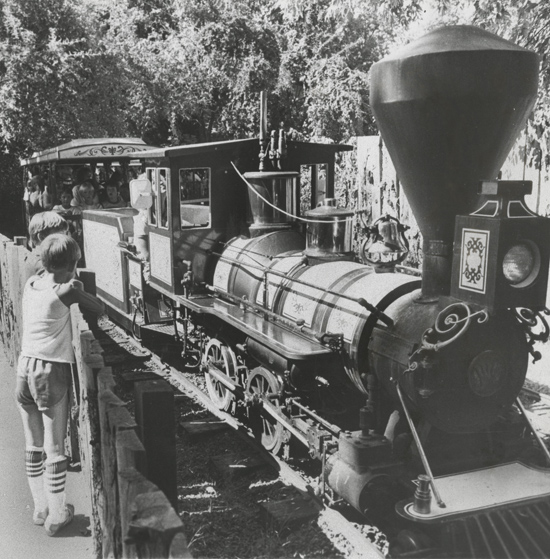
Since part of the P.V.R.R. ran through what became Lagoon-A-Beach, it had to close during construction in the late 1980s. At one time, it was planned to connect to the Wild Kingdom track for one long train ride, but that plan was never carried out and the P.V.R.R. ended up staying closed permanently.
The station is now the David E. Sperry Model Train Museum and a section of track can still be seen behind the building. The truss bridges were relocated further upstream on Farmington Creek for use on the Lagoon Trail, which runs along the east boundary of the park. The train that was used for the P.V.R.R. is now used for the Wild Kingdom Train. It replaced the engine that is now on display near Rattlesnake Rapids, which is about where the track used to be when it passed the Log Flume.
Read more about the Pioneer Village Railroad…
SPEEDWAY, SR., 1960-2000
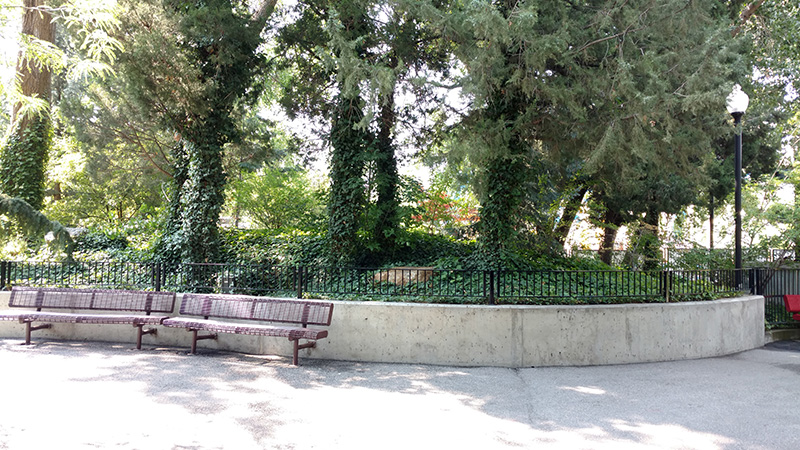
In front of The Spider sits a humble hill, that few notice, even as they rest on a bench under the shady trees. Even people who remember the ride don’t realize this is the last piece of one of Lagoon’s most popular rides of the 20th century. This hill was originally part of the overpass for Speedway, Sr., an automobile ride based on Disneyland’s famous Autopia.

It’s likely that the ride closed because of increasing maintenance costs. The piece of land it once occupied was replaced by two rides – Cliffhanger and The Spider. The service station was also torn down and the Soccer Darts game now sits in its place. Most of the cars were scrapped, but a few were sold.
Read more about Speedway, Senior…
TOP ELIMINATOR, 1996-2011
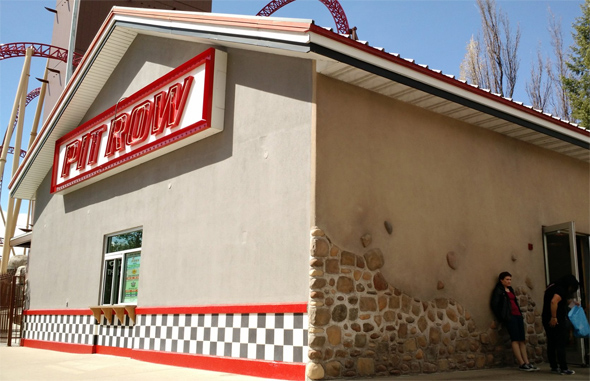
After riding Cannibal, guests exit through a gift shop that is made to match the feel of the ride – except for the south side of the exterior, which has an unusually large sign above a ticket window for Double Thunder Raceway.

The building was built almost two decades before Cannibal opened. The Pit Row sign used to be on front. In addition to the gift shop, there was a ticket counter in the middle for the Top Eliminator dragsters and later, Double Thunder go-karts. In the back northwest corner, there was a small room used for training drivers for Top Eliminator. The large back doors where people now exit from Cannibal were garage doors for the dragsters to be pulled into the building for winter storage. The ticket window on the south side was formerly a door where riders entered the Double Thunder area, which could only be accessed through the building at the time.
After the 2011 season, the ride closed and demolition began on the track in preparation for construction of Cannibal. The control tower was torn down a few years later. A less noticeable piece that still remains is a hill at the west end of Cannibal, which was part of the long berm that extended along the north side of Top Eliminator to reduce the noise from the dragsters.
Read more about Top Eliminator…
PATIO GARDENS, 1954-1969
The large building that currently contains the Game Time arcade, Dracula’s Castle and the Frightmares attraction, Seance, was originally Lagoon’s Patio Gardens – a legendary concert venue that showcased some of the biggest acts of the 1950s and ’60s. Today, you’d never know it once echoed the sounds of Jimi Hendrix or the Rolling Stones, but there are a few small elements still visible from those days, aside from the building itself.
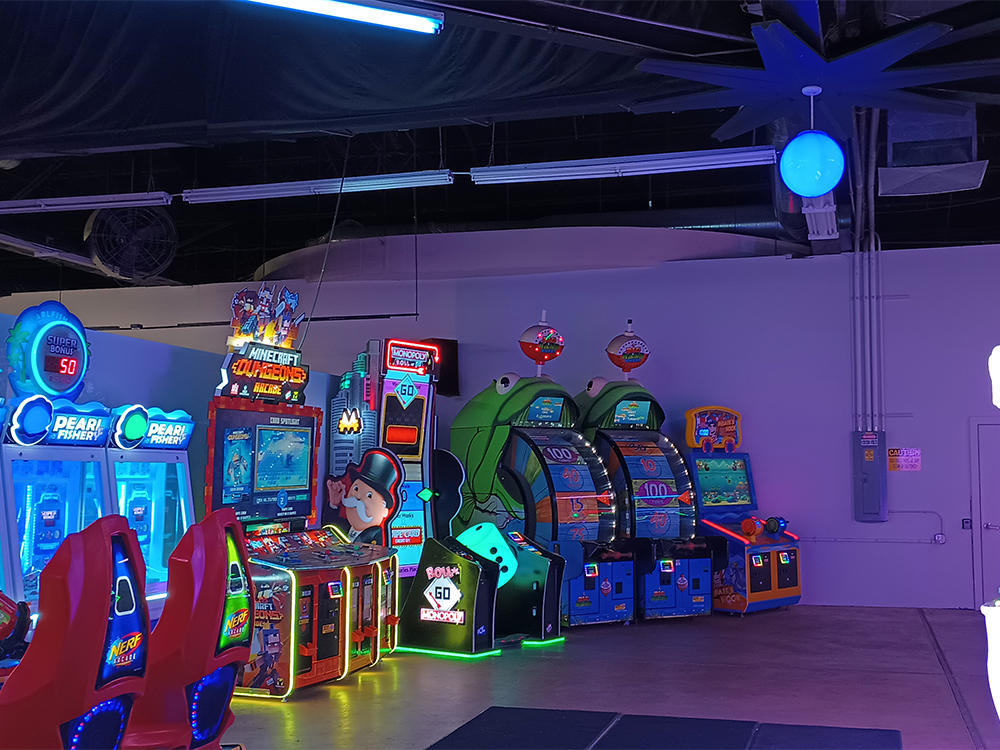
The stage was on the north side of the room and you can still see an overhang near the prize counter. The starburst-style lighting ornamentation is also still intact. The game on the outside southeast corner was where the ticket booth used to be.

Lagoon always drew the biggest acts of the day, but when popular music started veering away from the family atmosphere Lagoon was trying to uphold, management decided to end the concerts and focus on their own in-house entertainment. Concerts were still held sporadically at different locations in the park in the ’70s and ’80s, but it was rarely anything like what was common in the glory days of the Patio Gardens.
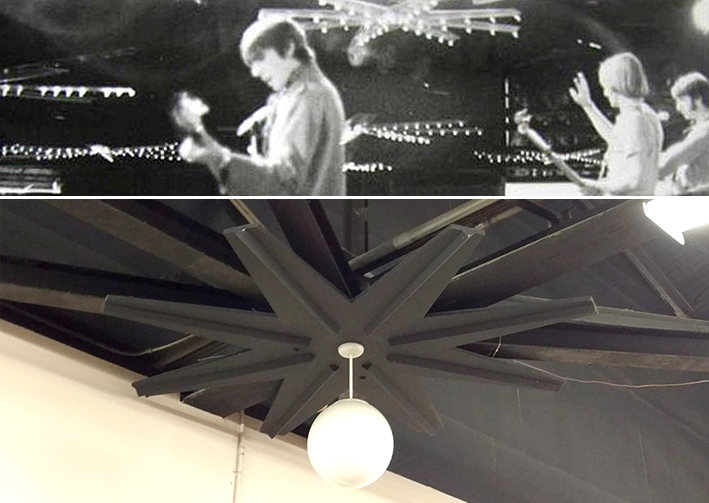
After the Patio Gardens closed, the building was converted into a roller skating rink for a short time. Then it became the Penny Arcade and finally the Game Time video game arcade. Dracula’s Castle was built into the southern portion of the building in 1974.
LAGOON MUSIC THEATRE, 1982-2008
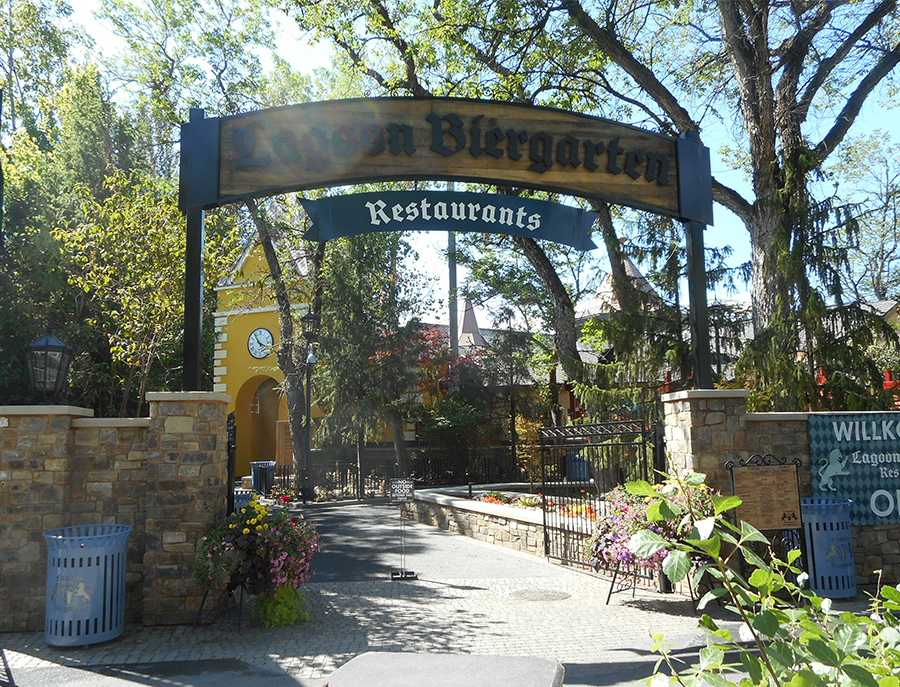
The Biergarten recently opened in an area bordered by Cliffhanger, The Spider and Roller Coaster. Much of this area was where Speedway, Sr. was located from 1960 to 2000. The Lagoon Music Theatre was built between Speedway, Sr. and Roller Coaster in 1982.
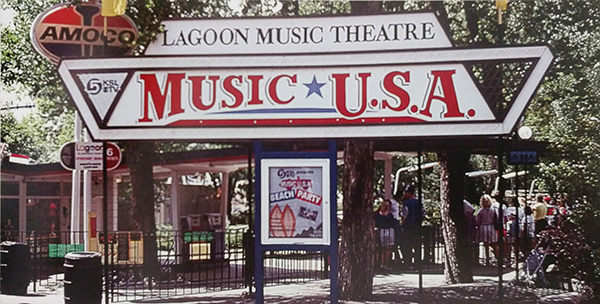
Many park guests remember relaxing in the shady amphitheater for nightly performances of song and dance. But it closed in 2008 and remained closed until construction began on the Biergarten in 2018. Most of the east planter and part of the short wall along the back of the theater were saved and incorporated into the design of the small German village.
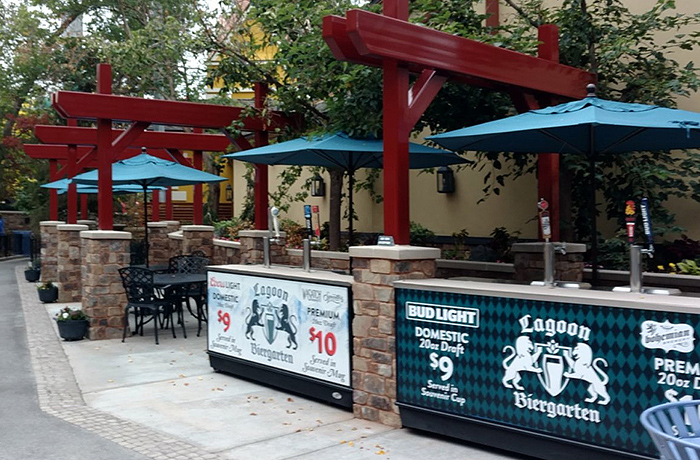
Read more about the Lagoon Music Theatre…
RACE TRACK, 1911-1984
If you’ve visited Lagoon on a busy day, you may have had to park out in a large field north of the park. Or maybe you noticed the field from the top of The Rocket or Sky Scraper. Even looking at aerial images on Google Maps, many might not realize this was once one of Lagoon’s many attractions in its early days.
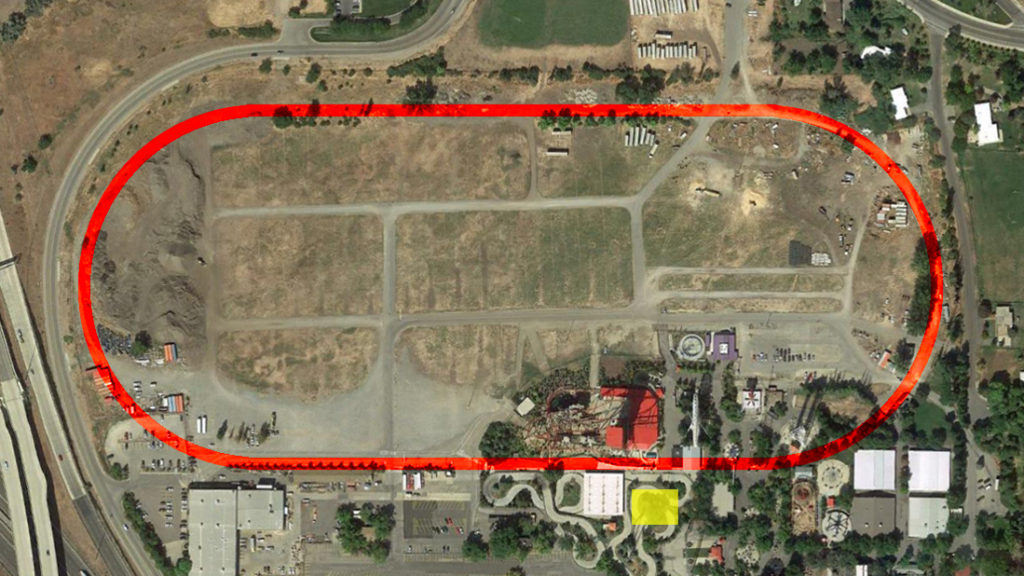
Although horse racing was declining elsewhere in the United States, it was just beginning to gain popularity in Utah when Lagoon added their own horse racing track in 1911. Horse racing was outlawed in 1913, but the track and grandstand were still used for a variety of races and events.

Lagoon’s management was close to having stock car races on the track in the 1960s, but that plan was quickly abandoned. Soon after, Lagoon began hosting the Davis County Fair again every year. A new grandstand was built for that purpose while also hosting rodeos and demolition derbies throughout the rest of the season. The county fair moved to a new fairground east of I-15 in the ’80s and Lagoon expanded northward in 1986, taking a chunk out of the old race track. The concrete grandstand remained and a few concerts were held there in the ’80s, but it was demolished in the late ’90s to make room for the Double Thunder Raceway.
Read more about the Race Track…
GOLF-FUN / PUTTER AROUND THE PARK, 1962-2008
A large, cone-shaped stone planter stands in the middle of several new kiddie rides at the north end of Kiddie Land. Some might think it looks like it used to be a fountain, which it was. But it was also part of something bigger when it was built.
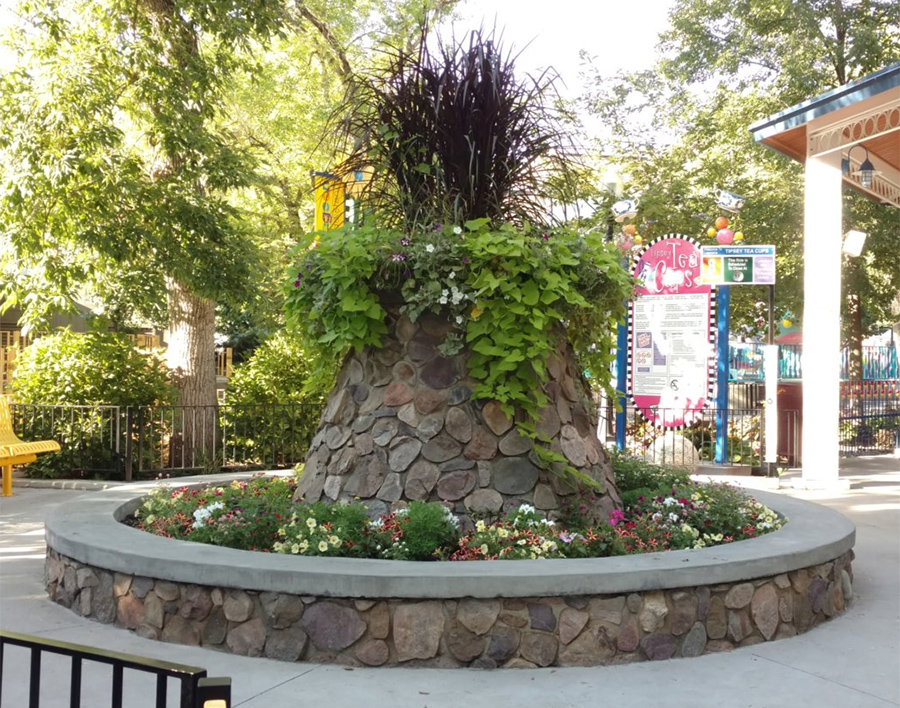
Lagoon’s first miniature golf course was designed by a nationally-known professional in the 1960s. Known as Golf-Fun, each hole featured an obstacle based on different regions of the United States. A couple decades later, it was renovated and renamed Putter Around The Park. This time the obstacles were miniature versions of Lagoon attractions. There was a double loop resembling Colossus: The Fire Dragon, a swinging pirate ship for Tidal Wave and others.
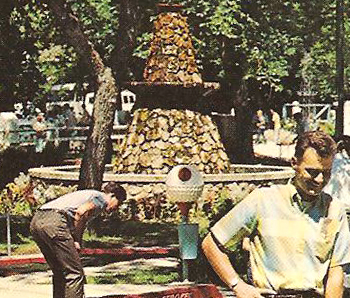
Many new kiddie rides were being added in the first decade of the 21st century and it’s possible the course just wasn’t popular enough to take up such valuable park real estate. Before Putter Around The Park closed in 2008, Bulgy The Whale had already taken over a portion of it near the entrance. Jumping Dragon was the first to open on the former course, followed by Tipsey Tea Cups, Red Rock Rally, Flying Tigers and Ruka Safari.
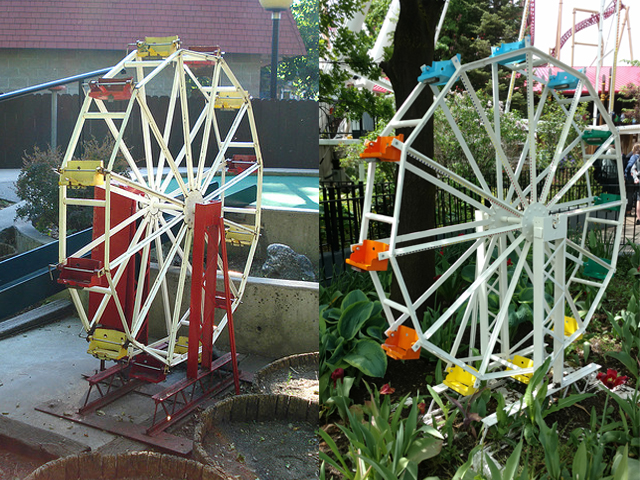

Even with the addition of five rides, Lagoon managed to retain many trees and the old cone-shaped fountain as a flower planter. The obstacles often popped up as decorations during Frightmares. Recently, the Bulgy The Whale and Ferris Wheel obstacles were repainted and placed in flower beds in the park. (Unfortunately, the whale was destroyed in a windstorm soon after).
Read more about Golf-Fun & Putter Around The Park…
Did you notice all of the annoying ads and pop-ups on this website? That’s because there aren’t any. The Lagoon History Project is a non-profit resource for info about Lagoon Amusement Park and is not owned or funded by Lagoon. Because of your donations and other support, this resource is made available to use for free, without a paywall, intrusive ads, pop-ups and cookies found on so many other websites today.
You can help make sure it stays this way by donating through Venmo or PayPal…
Thank You!

MORE FROM LHP

MORE FROM LHP
1. The gorilla reportedly had issues in 2024 and was removed at the end of the season. Whether or not the figure will ever appear anywhere again is uncertain.


